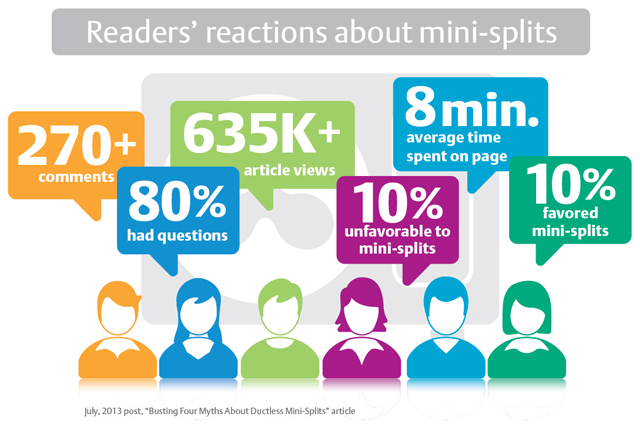
Revisit the Four Myths that I Proposed were “Busted” Three Years Ago
Revisiting the July, 2013 post, “Busting Four Myths About Ductless Mini-Splits”
When I wrote the “Busting Mini-Split Myths” article in 2013, I did not think it would become the most viewed article on our new website but it has over 365,000 page views and counting! I guess I would attribute the popularity of this topic to how new these systems are and how different they are from conventional, ducted, central HVAC systems, which are found in over 80% of the homes in the U.S. However, in addition to the volume of traffic the number and quality of the posted comments and questions has also been remarkable (over 270 to date).
Although we started out trying to provide a balanced view on this new technology for consideration, I found that I also learned some things as the user feedback continued to come in. This led our team to do some additional consumer research into the U.S. Mini-Split phenomena and this research will now appear in some new articles written by Eric Strausbaugh. Without going into the details of the study, I thought I would use some of the findings from the study, along with the knowledge contained in the many posts on this site, to revisit the four myths that I proposed were “busted” three years ago.
Myth #1 – The sales of ductless mini-spit systems continue to grow and will dominate the U.S. market.
Status: Still Busted. While mini-splits are growing a little faster than the sales of central systems on a unit basis, the dollars spent on these systems and the number of BTUs of capacity getting installed is still a fraction of that spent on traditional central systems. The reason for this is that the majority of the installed base of homes (over 80%) have pre-existing ductwork. It is simply less expensive to replace a ducted system with another ducted. The air quality and humidity control benefits from central AC are also contributing factors to the staying power of central systems.
Myth #2 – Ductless mini-splits are ideal whole-home HVAC solutions in the U.S.
Status: Still Busted. Our recent research suggests that only a small percentage of people are trying to use mini-splits as a whole-home heating and air conditioning solution; these are mostly in very small homes with no existing ductwork available. What appears to be more popular recently is the “hybrid” approach of keeping the central system for the bulk of the whole home comfort, air flow, air quality and humidity control but also use one or more mini-splits to address areas where consumers want more direct control or where the central, ducted system is not keeping up. Our research articles will go into more detail about this and theories about why this is happening.
Myth #3 – Ductless mini-splits are more energy efficient because there are no air leaks in the ductwork.
Status: Mixed. Based on our research and the comments on the original article, I would say that there are definitely instances where poor or failing ductwork has led to major problems with central systems. No one can argue that the most efficient way to run an air conditioner is to turn it off. If you intend to turn off an entire mini-split zone for long periods, these systems will use less energy than a home that does not have zones that can be shut off. I am giving this a “mixed” rating due to the comments about people also using zones in ducted systems, in addition to comments about energy losses in the long line sets for mini-splits.
However, it has been shown that mini-split installation can also have serious “leaks” as long line sets on the outside of the house can pick up heat in the summer and lose heat in the winter. The result can be significantly higher energy costs than would be expected based upon the rated efficiency of the system.
Myth #4 – Ductless mini-splits provide superior comfort and quality of life.
Status: Mixed. Based on user feedback, I would have to say that for certain situations mini-splits can do a great job and at reasonable costs. However, it would also appear that for whole-home solutions in larger, U.S.-style homes, the hybrid approach of using a base central HVAC system along with some mini-splits for certain areas provides the best overall approach to both comfort and energy efficiency. Combining this hybrid approach with an automated duct zoning system for the main central HVAC would also improve the performance of the overall hybrid approach.
The Bottom Line on Ductless Mini-Splits
If you want to learn more about this topic, check out our first article on the survey of over 350 people who have purchased mini-splits in the past 1-5 years. In the meantime, we would encourage anyone in the market to get a few different quotes for each of the various system types that are available today and consider mixing and matching them to meet your unique needs. It is important to get multiple quotes not only to get the best price, but also to find the right contractor who can recommend the best equipment solutions for your situation, then install and service them well.
To download the infographic in PDF, please click here.




